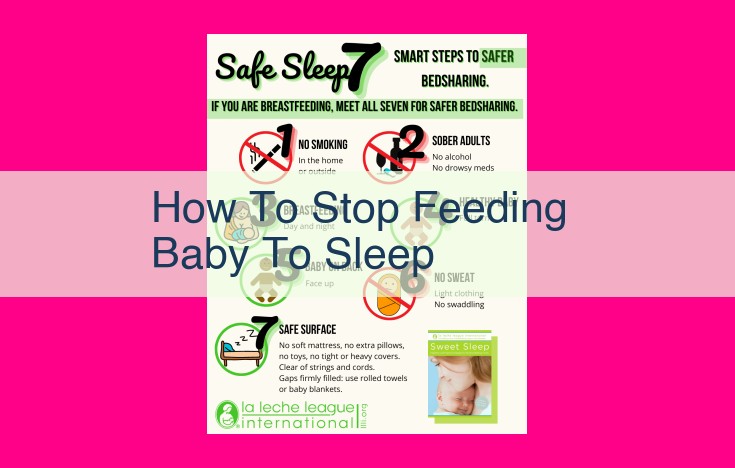How To Break The Feed-To-Sleep Cycle And Improve Infant Sleep

To wean infants from feeding to sleep, seek guidance from sleep experts. Implement sleep training methods like fading, night weaning, and self-soothing. Establish a consistent bedtime routine with comforting rituals. Create a soothing sleep environment with proper temperature, lighting, and sound. Introduce sleep aids like swaddles, sleep sacks, and white noise machines. Provide a safe crib or bassinet and use baby monitors for parental reassurance.
Professional Guidance for Restful Infant Sleep
When it comes to ensuring your little one’s optimal sleep, seeking professional guidance can make a world of difference. Fortunately, there are experienced individuals and organizations dedicated to providing evidence-based advice on infant sleep.
-
Sleep Consultants: These experts specialize in analyzing infant sleep patterns and developing tailored plans to address specific challenges. They are trained to identify underlying causes of sleep difficulties and provide customized solutions.
-
National Sleep Foundation: The NSF is a renowned organization that conducts extensive research on sleep and provides comprehensive information on infant sleep best practices. Their website offers a wealth of reliable resources, including age-specific guidelines and practical tips.
-
Pediatricians: Your child’s pediatrician can also be a valuable source of information on infant sleep. They can evaluate your baby’s health and provide personalized recommendations based on their medical history and overall well-being.
By consulting with these professionals, you can gain invaluable insights into your infant’s sleep patterns and receive expert guidance on implementing effective sleep training methods and establishing a supportive sleep environment for your precious little one.
Effective Sleep Training Methods for Infants
Understanding the Principles
Sleep training methods aim to teach infants how to fall and stay asleep independently. Three of the most effective methods are:
- Fading technique: Gradually reduce the amount of assistance (e.g., rocking, feeding) provided at bedtime until the infant can fall asleep on their own.
- Night weaning: Gradually stop offering feedings throughout the night, allowing the infant to learn to self-soothe.
- Self-soothing: Teaching the infant to calm themselves without external assistance (e.g., pacifier, rocking).
Implementing the Methods Effectively
Fading Technique:
- Start slowly: Begin by reducing assistance by a small amount each night (e.g., shorten rocking time by 5 minutes).
- Be consistent: Follow the schedule consistently, even on weekends or during setbacks.
- Provide reassurance: Comfort the infant with soothing words and touch, but avoid feeding or holding them.
Night Weaning:
- Establish a feeding schedule: Set specific times for night feedings and stick to it.
- Gradually reduce feedings: Once the infant is comfortable with the schedule, gradually reduce the number of night feedings.
- Offer water or a pacifier: If the infant wakes up hungry, offer water or a pacifier to comfort them.
Self-Soothing:
- Create a calm environment: Ensure the room is dark, quiet, and cool.
- Establish a bedtime routine: Follow a consistent routine before bed, such as a bath, massage, and lullabies.
- Use a white noise machine or fan: Block out distractions and create a soothing atmosphere.
- Allow time for self-soothing: Give the infant a few minutes to try to calm themselves before intervening.
Establishing a Conducive Sleep Environment and Calming Routines
Creating a serene and consistent sleep environment is paramount for fostering healthy sleep habits in infants. A well-established bedtime routine plays a crucial role in signaling to your baby that it’s time to settle down. Consider incorporating relaxing activities such as a warm bath, a gentle massage, or soothing lullabies into your child’s nightly routine.
Beyond the routine, the physical environment of your baby’s sleeping space matters immensely. Optimal temperature, dim lighting, and calming sounds can create an inviting atmosphere for sleep. It’s essential to keep the room at a comfortable temperature, as overheating or being too cold can disrupt sleep. To minimize distractions and create a peaceful ambiance, use blackout curtains or white noise machines to block out external noise.
Finally, finding alternative ways to comfort your infant without resorting to feeding is important. While feeding can be a natural way to soothe a baby, it’s not a sustainable solution for long-term sleep training. Instead, try rocking your baby, patting them gently, or offering a pacifier. These methods can provide comfort and help your baby self-soothe and drift off to sleep independently.
Sleep Aids and Accessories for Peaceful Infant Slumber
When it comes to ensuring a peaceful night’s sleep for your little one, choosing the right sleep aids and accessories can make all the difference. These helpful tools can create a comforting and conducive environment that promotes sound slumber and restful nights.
Swaddling and Sleep Sacks
Swaddling your infant can mimic the secure and cozy feeling of being in the womb. It helps reduce the startle reflex, promotes self-soothing, and improves sleep quality. Sleep sacks are a safe and convenient alternative to swaddling, providing warmth and a gentle sense of containment without restricting movement.
White Noise Machines
White noise machines are invaluable for blocking out distracting noises that can disrupt sleep. By creating a constant, soothing sound, they mask household sounds, traffic noise, and even baby’s own noises. This creates a more tranquil sleep environment, allowing your baby to fall and stay asleep more easily.
Safe and Comfortable Crib or Bassinet
A safe and comfortable crib or bassinet is essential for infant sleep. The mattress should be firm and fit snugly within the frame, and the crib should meet all safety standards. Consider adding a soft and breathable blanket or sheet for extra warmth and comfort.
Baby Monitors
Baby monitors provide peace of mind for parents, allowing them to monitor their baby’s breathing and movements from another room. Choose a monitor with clear audio and video quality, and position it within reach of your baby’s crib for optimal monitoring.